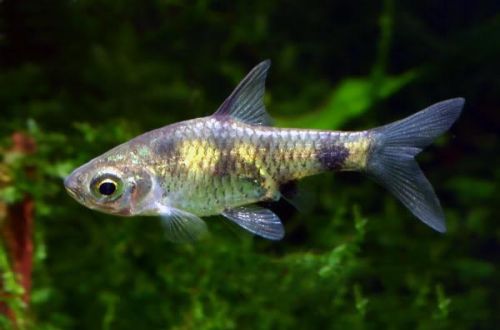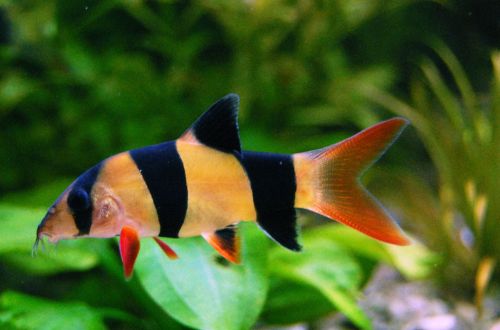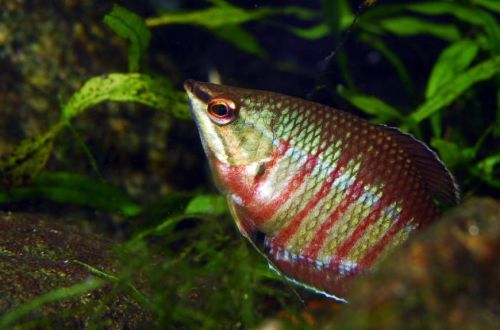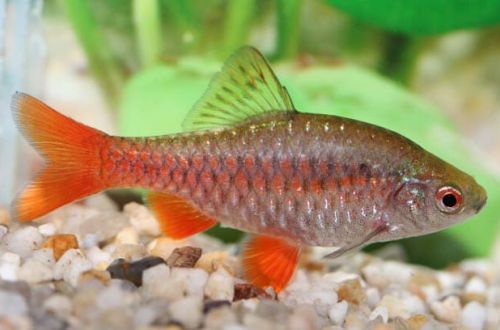
Yellow Barbus
The little yellow barb, scientific name Pethia aurea, belongs to the Cyprinidae family. A small unpretentious peaceful fish, a flock of which can decorate any small aquarium. Easy to keep and breed. May be recommended for beginner aquarists.

Contents
Habitat
It comes from Indochina from the territory of Northern and Eastern parts of India and bordering Bangladesh. It is found mainly in the Ganges Delta. Inhabits regions rich in aquatic vegetation and never swims into open waters.
Brief information:
- The volume of the aquarium – from 40 liters.
- Temperature – 18-24°C
- Value pH — 6.0–7.0
- Water hardness – soft (1-10 dGH)
- Substrate type – any
- Lighting – subdued
- Brackish water – no
- Water movement – little or no
- The size of the fish is about 2.5 cm.
- Feeding – any food of suitable size
- Temperament – peaceful
- Content in a group of 10 individuals
Description
A miniature, to say the least, tiny fish, reaching a length of only 2.5 cm. Outwardly, it resembles its relative, the Sunny Barbus, only smaller. The coloration is yellow-gray with large dark spots evenly spaced throughout the body. Fins are translucent. Sexual dimorphism is weakly expressed. It is noted that in females the abdomen is larger, but due to the small size of adults, this feature is not so obvious.
Food
Omnivorous species, undemanding to the diet. Will accept most popular foods of the right size. Able to adapt exclusively to dry products (flakes, granules). If possible, they will not refuse live or frozen artemia, daphnia, and bloodworms.
Maintenance and care, arrangement of the aquarium
Optimal aquarium sizes start at 40 liters, although experienced aquarists can successfully keep Little Yellow Barbs in smaller tanks. The design uses a large number of aquatic plants, including floating ones, and various shelters in the form of snags or any decorative items.
Water conditions should be maintained at slightly acidic pH and low hardness. The filtration system and weekly replacement of part of the water with fresh water will prevent the accumulation of organic waste. When choosing a filter, you should give preference to those models that do not cause excessive flow. This is important because the fish do not tolerate strong water movement.
Behavior and Compatibility
Peaceful schooling fish, it is recommended to keep at least 10 individuals in a group. Due to their modest size, it is not worth settling together with large fish. Even herbivorous species can be dangerous if they accidentally eat this little Barb. This is especially true for catfish, which eat everything that fits in their mouths.
Breeding / breeding
The appearance of fry in the general aquarium is possible, but their survival rate will be extremely small. Juveniles fall prey to adult fish and often die from lack of food. With the onset of the mating season, the fish scatter the eggs in the water column, and from that moment they become left to their own devices. Barbs’ parental instincts are not developed, therefore, on occasion, they will enjoy their own offspring with pleasure.
Survival can be increased by timely transfer of eggs or fry that have appeared to a separate tank with identical water conditions. This spawning aquarium is equipped with a simple airlift filter with a sponge and a heater. A separate light source is not required. Shade-loving mosses and ferns or artificial plants can be used as decoration.
The incubation period lasts 24-36 hours depending on the water temperature. After another 3-4 days, the fry begin to swim freely in search of food. Feed with specialized micro food, ciliates shoes. Artemia nauplii may be offered as they mature. Selecting the right food is probably the most difficult part of breeding Little Yellow Barbs.
Fish diseases
In a balanced aquarium ecosystem with species-specific conditions, diseases rarely occur. Diseases are caused by environmental degradation, contact with sick fish, and injuries. If this could not be avoided, then more about the symptoms and methods of treatment in the section “Diseases of aquarium fish”.





